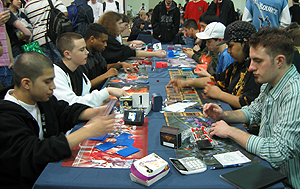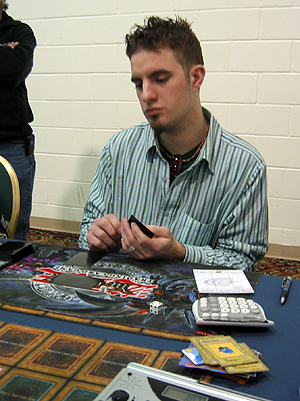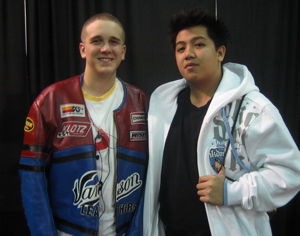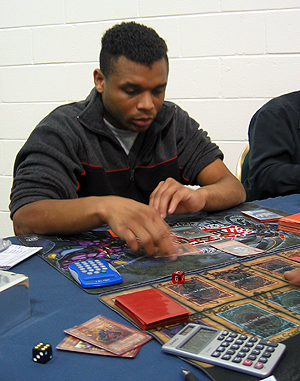Tempo, tempo, tempo.
As much as many duelists are currently on a card advantage kick, the concept of +1 and –1 was inherently more important to the previous Advanced format than it is to this one. While card management on the numeric level was the defining force of last April’s Advanced environment, current play trends have been far more influenced by tempo—the rate at which cards are expended on a turn-by-turn basis.
Fast tempo, which resulted in the establishment of topdecking situations, allowed Paul Levitin to win Shonen Jump Los Angeles in November. But the format has since rebounded. Shonen Jump Championship San Francisco marked a turning point in the format’s ongoing progression, as many duelists began playing slower decks rather than the aggressive Warrior Toolbox builds that were once so common. While Flip-Flop Control was essentially a slow-tempo deck without a proper win condition at the time, duelists with all sorts of strategies were experimenting with Dekoichi the Battlechanted Locomotive, Apprentice Magician, Magical Merchant, and other cards that robbed opponents of the ability to gain card advantage through battle. While this trend was on the upswing at San Francisco, it was not until the recent Shonen Jump Championship in Durham, North Carolina, that it reached its apex.
 Though I did the coverage for Durham, I feel like I should re-emphasize one of the major points from that tournament. If you looked at the top twenty tables at any point of the day after the third round, you could see how slow the duels were. Four months ago, set monsters were relatively rare, and when they were seen, they didn’t usually stick around for very long.* In Atlanta, many duelists were surprised at the low number of flip-effect monsters being played. The top tables at Durham were just the opposite, and most games featured long standoffs in which players would take turns setting cards, each building towards a situation in which they felt confident they could take the game in a single push.
Though I did the coverage for Durham, I feel like I should re-emphasize one of the major points from that tournament. If you looked at the top twenty tables at any point of the day after the third round, you could see how slow the duels were. Four months ago, set monsters were relatively rare, and when they were seen, they didn’t usually stick around for very long.* In Atlanta, many duelists were surprised at the low number of flip-effect monsters being played. The top tables at Durham were just the opposite, and most games featured long standoffs in which players would take turns setting cards, each building towards a situation in which they felt confident they could take the game in a single push.
The duelists who had once preached the virtues of card-for-card exchanges had finally realized how to beat the current metagame: play more slowly and don’t run headlong into those Sakuretsu Armors. The problem was that they had all figured it out at the same time.
The result was a tournament that was exceedingly slow on a gameplay level. It was a markedly different environment from what most duelists expected, and the slow tempo claimed just as many victims as it made victors. Today, I want to explore the impact of this relatively sudden shift in play style.
The Success of Zachary Austin
 Despite his defeat on Day 2 at the hands of Jerry Wang, Zachary Austin’s plans for the tournament were nothing short of brilliant. He played his deck extremely well and knew what to do in most situations based simply on practice. The deck choices he made were very well-reasoned, resulting in a burn build that was eerily reminiscent of Cindie Uddstrom’s deck from the World Championships. Compare the two decks and you’ll see that though the lists are very different, the core cards and strategies are nearly identical.
Despite his defeat on Day 2 at the hands of Jerry Wang, Zachary Austin’s plans for the tournament were nothing short of brilliant. He played his deck extremely well and knew what to do in most situations based simply on practice. The deck choices he made were very well-reasoned, resulting in a burn build that was eerily reminiscent of Cindie Uddstrom’s deck from the World Championships. Compare the two decks and you’ll see that though the lists are very different, the core cards and strategies are nearly identical.
Both burn decks feature the defining nine-card trap lineup of Ojama Trio, Just Desserts, and Secret Barrel, creating a burn engine that takes advantage of a slow rate of play. In Cindie’s era, she could depend on the popularity of Thousand-Eyes Restrict to deliver the precise tempo that she wanted. Austin couldn’t rely on that luxury, so his deck is fine-tuned to create a slow tempo in more proactive ways. Featuring Dekoichi the Battlechanted Locomotive, Mask of Darkness, and Spirit Reaper to slow down the game, his deck is heavier on monsters than Uddstrom’s. Austin probably had little idea of just how slow the metagame would be, so he constructed an intelligent deck that could nudge a duel in the direction he wanted. It was a good plan.
The kicker? That plan was practically extraneous for most of Day 1. Austin went undefeated in the slow-as-molasses metagame, able to sit back and set card after card, encouraging the opponent to do the same. While the average competitor sat and waited to draw into a definite win, Austin could let the field fatten while drawing into more cards himself. He’d then burn his opposition to cinders when it was too late for them to do anything about it. Though he used his side deck all day long, the format was such a good fit that he probably could have made the Top 8 without it. Tempo made many duelists into losers at Shonen Jump Durham, but Austin was one of the few who got the long end of the stick.
That’s not to say that Austin only got lucky. He deserved every win he got, and his creative method of dealing with burn’s vulnerability to side decking was genius: just stop playing burn when you hit the second game and pursue a totally different win condition. Competitors who lost due to their own slow tempo in the first game would side deck aggressively, intending to create a fast tempo in the remaining duels. Faced with a second game in which field presence would be minimal, Austin was again able to capitalize on the pace of play, this time by scoring one-turn wins through Cyber-Stein.
In other words, Austin would create a slow game in the first duel of a match. He’d then punish the opponent for letting it happen. When that opponent would turn around and act in the opposite way for game two, Austin was ready with a new strategy to punish him or her for that as well. It was a smart decision, bolstered by the fact that Austin was often getting ideal first-game conditions handed to him on a silver platter. Though Austin’s success wasn’t dependent upon metagame trends, it’s important to recognize how those conditions affected his matches. His deck was a good pick for a slow environment.
What Happened to Dale Bellido and Paul Levitin?
 On the other side of the spectrum was the unfortunate failure of the decks played by Team Scoop, as well as many of the members of Team Superfriends. If you haven’t seen them yet, be sure to check out a profile of both decks here.
On the other side of the spectrum was the unfortunate failure of the decks played by Team Scoop, as well as many of the members of Team Superfriends. If you haven’t seen them yet, be sure to check out a profile of both decks here.
The theory behind the deck that Levitin created was perfect for a Warrior-heavy environment with a fast tempo. It would capitalize on the exchanges initiated by cards like Smashing Ground and Sakuretsu Armor, creating a simplified duel in which each duelist was playing with relatively few cards. At that point, the card advantage created by Chaos Sorcerer, Mobius the Frost Monarch, or Zaborg the Thunder Monarch would be increased and could quickly lead to victory. The plan was to reduce the number of cards on the field, amplify the ramifications of effects that could give easy mathematical advantage, and then use that advantage to win.
In any metagame where a fast tempo is ensured, this would have been a great plan. Heck, when the decks were shown to me before the first round, I thought they’d do spectacularly well. The only bad matchup that Levitin and Bellido foresaw was Flip-Flop Control. Their deck needed a fast tempo to create a simplified field—otherwise, the impact of their card advantage would be minimized. It’s the difference between losing two cards when you only have three, and losing two when you have six. The Levitin/Bellido strategy simply would not work against decks that could keep card counts high and maintain a slow tempo.
Unfortunately for them, that kind of deck was all over Durham.
It’s difficult to put a finger on why Shonen Jump Championship Durham turned out to be such a slow environment, but that’s the reason why Levitin and Bellido’s deck failed. One can debate their card choices or their specific plays, but I don’t think those are the main problem. The surprise metagame was stacked completely against them, and there was just no way that they could win in a slow-tempo environment. While very few competitors were running what I would call a straight Flip-Flop Control deck, many were incorporating elements of that strategy into their plans, and Levitin and Bellido got stuck footing the bill.
The Setting Sun
 In fact, the combination of hallmarked play trends into single, cohesive strategies can be viewed as the legacy of Shonen Jump Championship Durham. Before Durham, it was relatively easy to classify decks as Warrior Toolbox, Soul Control, Flip-Flop Control, or any of the other labels given to distinct strategies. As a result, it was also easy to peg the play speed each deck needed to establish. But if you look at the Top 8 decks from Durham—especially the final two—classifying them is a real challenge. Jason Holloway’s deck combined the Pot of Avarice engine of a Flip-Flop Control deck with an offensively skewed monster lineup. Though Christopher Flores’s deck had many of the hallmarks of a textbook Warrior Toolbox, he was also using monsters that would have been at home in Flip-Flop or Soul Control. He was even running Morphing Jar, a card that no cookie-cutter archetype had typically been using for months.
In fact, the combination of hallmarked play trends into single, cohesive strategies can be viewed as the legacy of Shonen Jump Championship Durham. Before Durham, it was relatively easy to classify decks as Warrior Toolbox, Soul Control, Flip-Flop Control, or any of the other labels given to distinct strategies. As a result, it was also easy to peg the play speed each deck needed to establish. But if you look at the Top 8 decks from Durham—especially the final two—classifying them is a real challenge. Jason Holloway’s deck combined the Pot of Avarice engine of a Flip-Flop Control deck with an offensively skewed monster lineup. Though Christopher Flores’s deck had many of the hallmarks of a textbook Warrior Toolbox, he was also using monsters that would have been at home in Flip-Flop or Soul Control. He was even running Morphing Jar, a card that no cookie-cutter archetype had typically been using for months.
These combinations of monsters, spells, and traps are indicative of a format that’s nearing its end. Virtually everything that can be done in this format has been done, and duelists know which cards to use and how to play them to create certain effects. Want to simplify the field by creating a fast flurry of even card exchanges? Run plenty of Smashing Ground, Sakuretsu Armor, and D. D. Assailant. Want to go in the opposite direction in order to see more cards from your deck? Use Magical Merchant, Dekoichi the Battlechanted Locomotive, and Mystic Tomato. Duelists have identified the core groups of cards that make decks work, and now they’re combining them to take the format to new levels.
Many archetypes as we know them are breaking down, and the lines between them are blurring. Shonen Jump Championship Durham was the result of this fact, which is probably why the metagame was so slow.
Where Do We Go From Here?
That’s a good question. If the current format weren’t going to be subjected to outside forces for say, two months, we’d probably wind up looking at a stagnant environment.
Of course, that won’t happen, because there are outside forces that will soon be at work. Shonen Jump Championship Orlando will be the first Shonen Jump Championship in which Shadow of Infinity will be legal, and Treeborn Frog is definitely going to change how the game is played. Many duelists are going to be trimming down the numbers of Sakuretsu Armors and Widespread Ruins in their decks in favor of more chainable traps that will allow them to get better mileage out of the Frog, and that alone is going to create a lot of openings.
The impact of this change is unpredictable at this point. It could allow aggressive decks the room they need to attack more often and keep monsters on the field, thus creating a faster format. If that happens, Warriors and other Beatdown strategies will get a boost. Or, it could result in a conservative environment in which both players refuse to take an aggressive stance until they’ve established card advantage over their opponents. That could be good news for burn and a variety of combo decks.
If I were a betting man (and I am), my money would be on the continued success of the slow tempo burn. I think whatever impact Treeborn Frog ends up having, duelists are going to be conservative with it at first, and that’s good news for Des Koala and its pals. At the same time, I think aggressive decks that use the Frog are going to do far better than timid ones. Kycoo the Ghost Destroyer and Mystic Swordsman LV2 will probably hold their status as sharp tech cards, and I think Ceasefire will be a great main deck call. I also think the Levitin/Bellido strategy will work wonders with a Frog or two. We’ll have to wait four more days to find out.
Of course, the format will only remain in that state for two Shonen Jump Championships. A week after Shonen Jump Los Angeles, we’ll have an entirely new Forbidden and Limited list.
Even in this sunset phase of the current Advanced environment, it’s an exciting time with plenty of changes on the horizon. Though this format will go out with a ribbit and a bang, it’s definitely in its final weeks. The timing of the new Advanced list couldn’t be better. We’re in the calm before the storm, and this next month is going to be a wild time for duelists.
Be sure to join us for live coverage of Shonen Jump Championship Orlando, when we’ll discover just how everything plays out! I can’t wait to see what the Top 8 decks will look like, and you’ll be able to see them for yourself once the event has concluded. While the current state of the game is clear, be sure to join us on Saturday, March 18. Orlando is going to be the first of many new changes as the Yu-Gi-Oh! TCG begins its next rebirth!
—Jason Grabher-Meyer
* With the obvious exception of Spirit Reaper, which was set frequently and did stick around for quite a while in many cases.